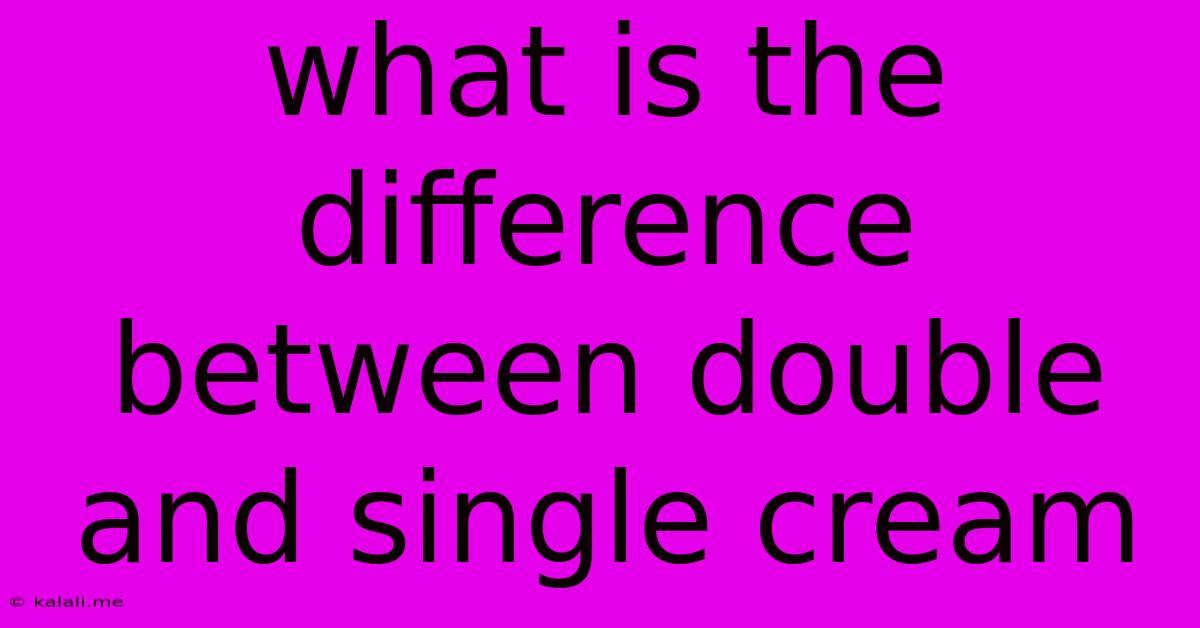What Is The Difference Between Double And Single Cream
Kalali
May 22, 2025 · 3 min read

Table of Contents
What's the Difference Between Double and Single Cream? A Creamy Conundrum Solved
Choosing between double and single cream can feel like navigating a culinary minefield. Both are delicious additions to coffee, sauces, and desserts, but understanding their key differences is crucial for achieving the perfect texture and taste in your recipes. This article will unravel the mysteries of cream, clarifying the distinctions between double and single cream, their fat content, uses, and how to best utilize each in your cooking and baking.
What is Cream?
Before delving into the differences, let's establish what cream actually is. Cream is the fatty portion of milk that rises to the top when raw milk sits undisturbed. The amount of fat present determines the type of cream, influencing its thickness, richness, and suitability for different culinary applications. This fat content is what largely distinguishes double cream from single cream.
Double Cream vs. Single Cream: A Head-to-Head Comparison
The primary differentiator between double and single cream is their fat content. This single factor influences their texture, taste, and culinary uses.
| Feature | Double Cream | Single Cream |
|---|---|---|
| Fat Content | Typically 48% or higher | Typically 18% - 22% |
| Texture | Very thick, rich, and luxurious | Lighter, thinner, less rich |
| Taste | Intensely creamy, buttery flavour | Milder, less intense flavour |
| Whipping Ability | Excellent, creates stiff peaks | Whipable, but less stable peaks |
| Uses | Creams, sauces, desserts, toppings | Sauces, soups, coffee, some desserts |
Double Cream: The Richer, Thicker Choice
Double cream, boasting a significantly higher fat content (48% or more), is characterized by its incredibly thick and luxurious texture. Its intense, buttery flavor makes it a decadent addition to desserts like crème brûlée, mousses, and ice cream. Its high fat content also makes it ideal for whipping, resulting in stiff peaks perfect for topping cakes and pies. Its richness also makes it a delicious addition to savory dishes, enriching sauces and soups.
Single Cream: The Lighter, More Versatile Option
Single cream, with its lower fat content (18%-22%), possesses a lighter, thinner consistency compared to double cream. Its milder flavor makes it a versatile ingredient suitable for a broader range of applications. While it can be whipped, the resulting peaks are less stable than those of double cream. Single cream is excellent for adding richness to soups, sauces, and coffee, as well as lighter desserts where a less intense creaminess is desired.
Choosing the Right Cream: A Recipe's Best Friend
Selecting the appropriate cream hinges on your recipe’s requirements. When a recipe calls for a rich, intensely creamy texture and excellent whipping capabilities, double cream is the superior choice. However, when a lighter, more delicate creaminess is preferred, single cream is the way to go. Always check your recipe carefully before selecting your cream; using the wrong type can significantly impact the final outcome of your culinary creation.
Beyond the Basics: Exploring Cream Alternatives
While double and single cream are popular choices, other cream options exist, such as whipping cream (often similar to single cream but specifically designed for whipping) and clotted cream (a thicker, richer option than double cream). Understanding the nuances of each type will allow you to expand your culinary repertoire and create truly exceptional dishes. Experimenting with different types of cream will enhance your cooking skills and lead to delicious discoveries in the kitchen.
Latest Posts
Latest Posts
-
Je T En Prie In English
May 22, 2025
-
What Does It Mean To Be In Credit
May 22, 2025
-
Throwing Someone Under The Bus Meaning
May 22, 2025
-
Upvc Door Latch Not Retracting Fully
May 22, 2025
-
Whats That Got To Do With The Price Of
May 22, 2025
Related Post
Thank you for visiting our website which covers about What Is The Difference Between Double And Single Cream . We hope the information provided has been useful to you. Feel free to contact us if you have any questions or need further assistance. See you next time and don't miss to bookmark.